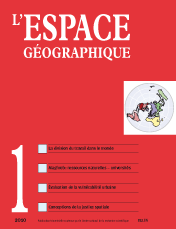

The relocation of industry: a core-periphery approach to global and European trends (6 fig., 2 tabl.)
This paper highlights the persistence of a global division of labour between the core, the semi-peripheries and the peripheries, on both the global and the European scale. Labour-intensive sectors were relocated to the peripheries in the 1975-2005 period, but the most technological sectors have largely remained in the centre. Trends in trade show the scale of the relocation to Asia-Pacific.
keywords: CENTRE, INDUSTRY, PERIPHERY, RELOCATION, TRADE
(2 fig., 1 photo)
The approach was tested in an area characterised by degradation of the natural environment and the living conditions of local farmers. It was designed to introduce the farmers into regional decision-making, enabling them to contribute to knowledge of their territory and participate in its transformation. The farmers’ discourse on the use of natural resources was mapped and compared with the projects proposed by the regional managers and with remotesensing images of the natural environment. The aim is to make the differences in perception explicit and use this information as the basis for the consultation.
keywords: CARTOGRAPHIC REPRESENTATION, CONSULTATION, DISCREPANCY IN PERCEPTION, TERRITORY
An urban vulnerability assessment method applied to the conurbation of Lyon (3 encadrés, 5 fig., 1 tabl.)
Risk management, long focused on controlling hazards, is moving towards vulnerability reduction. This presupposes an accurate knowledge of vulnerability. This research, applicable to any place, proposes a methodology for vulnerability assessment on the basis of the conurbation of Lyon. The study is based on a decision support method that ranks the issues in order to deduce vulnerability functions using expert assessments. A specific view of risk is obtained from overlapping layers of hazards.
keywords: ANALYTIC HIERARCHY PROCESS, GIS, RISK, VULNERABILITY
Spatial autocorrelation: lessons from scales (1 encadré, 6 fig., 1 tabl.)
The use by geographers of local indicators of spatial autocorrelation has spread since 1995. Generally treated from a theoretical point of view, applications are still rare. However, the tools are now available to measure the spatial dimension of social phenomena. This paper proposes retracing the move from global to local indicators, not from a formal mathematical point of view, but emphasising a geographical reading of the results produced and what they say about spatial patterns. The aim here is to examine the potential and the limitations of these tools, and to encourage their use for data analysis in geography.
keywords: GEOSTATISTIC, LISA, SCALE, SPATIAL AUTOCORRELATION
University infrastructure in Tunisia: from marginalisation to integration into town planning (10 fig.)
University education and town planning in Tunisia have changed considerably since the early 1990s. The city is being restructured and its spatial organisation is undergoing major changes. At the same time, university education is driven by the development of mass universities to cater to a more diverse student body. In response to the growing number of students, university infrastructure is being relocated, expanded and reorganised within the city. The student population is helping break down the divisions between urban structures and integrate universities into the dynamics of the city.
keywords: INFRASTRUCTURE, DEVELOPMENT, LOCATION, PLANNING, UNIVERSITY
(3 fig., 4 tabl.)
A geoethical approach is an analysis of geographical values and, through them, conceptions of territorial justice that structure public debate. Depending on the circumstances, the geoethical norms promoted might be tolerance, ownership, equity or harmony. Geoethics can be applied to several forms of social evaluation (academic, institutional). The analysis of the discourse of French magazines provides a first example of the way in which social preferences structure spatial organisation.
keywords: GEOETHICS, PLURALISM, PUBLIC DEBATE, SPATIAL JUSTICE, VALUE
Vert Taklamakan (1 fig, 2 photos)
Book reviews
In this issue of l’Espace géographique, you will find critical reviews of the following books
MOÏSI D. (2008). La Géopolitique de l’émotion. Comment les cultures de peur, d’humiliation et d’espoir façonnent le monde. Paris: Flammarion, 272 p. (Jean-Paul Ferrier, université d’Aix-Marseille 1)
BERTI D., TARABOUT G. (dir.)(2009). Territory, Soil and Society in South Asia. New Delhi: Manohar, 379 p. (Dalal Benbabaali, Centre de Sciences humaines, New Delhi)
Alternatives économiques (2009). «La ville autrement». Hors-série poche, no 39, 144 p. (Marc Dumont, université de Rennes 2)
MONTULET B., HUBERT M., JEMELIN C., SCHMITZ S. (dir.)(2005), Mobilités et temporalités. Bruxelles: Publications des Facultés universitaires Saint-Louis, 228 p. (Giovanni Fusco, université de Nice-Sophia Antipolis)
BONNET M., AUBERTEL P. (dir.)(2006), La Ville aux limites de la mobilité. Paris: PUF, 320 p. (Giovanni Fusco, université de Nice-Sophia Antipolis)
L’espace géographique 4/09![]()
![]() L’espace géographique 2/10
L’espace géographique 2/10
For subscribe or buy this issue: BELIN
![]() L’Espace géographique: contents
L’Espace géographique: contents
Last modified: June 4, 2010